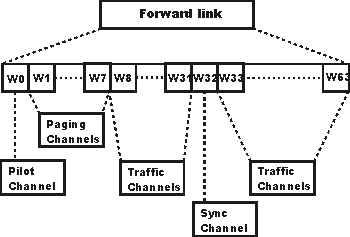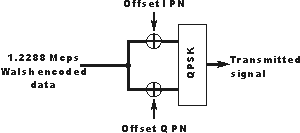IS-95 Data Channels
The data channels used within IS-95 - IS95A and IS-95B to carry the different forms of data within the overall cdmaOne system
cdmaOne / cdma2000 Technology Includes:
IS95 / cdmaOne
IS95 radio access interface
IS95 handoff / handover
IS95 data channels
cdma2000 1X
cdma2000 1X data channels
cdma2000 1X Advanced
cdma2000 1X EV-DO
1X EV-DO radio interface
1X EV-DO data channels
1X EV-DO Rev.B
1X EV-DO Advanced
UMB: 4G UltraMobile Broadband
As with any cellular telecommunications system, within IS-95 different channels are used to carry the different forms of data.
The IS-95 channels can be split into those for the forward link and those for the reverse link. The IS-95 channels differ between the forward and reverse links as a result of the different requirements and the different way in which the links operate. Also Walsh codes need to be synchronised if they are to remain orthogonal. As the signals transmitted from the mobile stations travel over different distances because of the variety of locations of the mobiles they will all arrive at slightly different times, and hence they will not be synchronised to one another. The addition of the PN code overcomes this problem, even though Walsh codes have been used for part of the spreading process in the mobile.
Structure of IS-95 channels in the forward link
This is a total of 64 IS-95 code channels that can be accommodated on each RF channel. The IS-95 channels in the forward link are arranged in the following fashion:
- Pilot channel
- Paging channels (up to seven)
- Sync channel
- Traffic channels
The IS-95 channels are associated with different Walsh codes - particular codes being used to support different functions as outlined below:

To generate the final signal, the data from the individual channels is multiplied with the Walsh codes to provide the individual IS-95 forward link channels. The output from this process is then further multiplied with the short PN codes. This provides a means of identifying the sector / cell from which the signal is coming for the handset / mobile

IS-95 channels in the forward link
The IS-95 forward link channels and their functions and make-up are summarized below:
- Pilot channel (PC): The pilot channel is transmitted as a reference by the base station to provide timing and phase reference for the mobiles, and carries no real data. The "data" carried by the channel is a continuous stream of zeros which is spread by Walsh code zero, which itself a stream of zeros. This is further spread by a pair of quadrature PN sequences. This means that the pilot channel is effectively the PN sequence with its associated offset. A measurement of the signal-to-noise ratio of the pilot channel also gives the mobile an indication of which is the strongest serving sector.
- Paging channels (PCH): This IS-95 channel is used to carry information to enable mobiles to be paged. Data carried by this IS-95 channel includes system parameters, voice pages, SMS and other broadcast messages. It occupies Walsh codes 1 - 7 dependent upon the system requirements. The PCH carries data at either 4.8 or 9.6 kbps - a field in the Sync Channel indicates the data rate being transmitted.
As with other channels there are a number of stages taken to produce the final channel. First the baseband information is error protected. After this the data is repeated if it is at a rate of 4.8 kbps, otherwise it is left as it is. Following this the data is interleaved and then scrambled by the decimated long PN sequence, and finally spread by the Walsh code for the particular channel assignment. In this process the long PN code is itself masked with a code which is specific to the channel being used. In this way the long PN code for Paging Channel 1 (using Walsh Code 1) is different to Paging Channel 4 (using Walsh Code 4). - Synchronisation channel (SC): This IS-95 channel is used to provide the timing reference to access the cell . This IS-95 channel always uses Walsh code 32. Each base station has a fixed timing offset to reduce the interference between adjacent base-stations.
The Sync channel incorporates an 80 mS superframe structure. This is divided into three 26.667 mS frames which correspond to the same length as the short PN sequences. This means that they align with the timing on the Pilot channel.
This IS-95 channel is allocated the least power of the overhead channels in the overall CDMA transmission. The data that is transmitted on this channel includes the system time, pilot PN of the base station, long code state, system ID, and the network ID. - Forward Traffic Channel (FTC): As the name implies, the Forward Traffic Channel is used to carry voice, user data, and also signalling information.
When carrying voice, the coded voice data does not require a constant bit rate and IS-95 allows the rate of the frames to change dynamically (every 20 ms). When the rate is reduced it reduces the level of interference to other users. The original vocoder specification used a set of rates based on divisions of 9.6 kbps. This is reflected in IS-95A. Later the vocoder was improved to give better voice quality and in IS-95B a vocoder was introduced with a rate set based on 14.4 kbps. The 9.6 kbps rate set was termed RS1 and the second based on 14.4 kbps was termed RS2. However data is always carried at full rate.
Forward channel modulation
The forward data appearing on the various IS-95 channels is brought together so that it can be summed and modulated onto the radio frequency carrier. The individual gains of each IS-95 channel are adjusted to provide the correct relative power for each channel - this is undertaken because the levels of traffic on each channel are always changing.
Once the channel gains have been set the signals are added coherently to form the spread spectrum signal. Then the I and Q components are each modulated onto a carrier and summed to give the final transmitted QPSK signal.
Structure of IS-95 channels in the reverse link
The IS-95 channels for the reverse link are quite different to those in the forward link. There are only two basic channels:
- Access channel
- Reverse traffic channel
The way in which these IS-95 channels are structured and assembled is also different. This is because they are generated within the mobile rather than the base station. In terms of the modulation, OQPSK is used where a half chip delay is introduced onto the Q channel of the modulation.
However orthogonal modulation schemes are used. The different mobiles are individually identified by a mask on the long PN code which is based on the Equipment Serial Number (ESN). The long PN code is used to give the final spreading of the data to 1.228 Mcps.
IS-95 channels in the reverse link
The two IS-95 channels in the reverse link are summarized below:
- Access channel (AC): This IS-95 channel is used by the mobile to communicate with the base station when no traffic channel has been set up. This IS-95 channel is therefore used for gaining acess toth e network, call origination requests and also for sending responses to paging commands that might be sent bythe network.
There can be up to 32 Access Channels on the IS-95 reverse link for each Paging Channel on forward link. Each AC uses the same PN but they are time shifted to enable the mobile to be uniquely identified. Data is sent at 4800 bps in a 20 mS time frame so that each frame contains 96 bits. - Reverse traffic channel (RTC): Like the Forward Traffic Channel, this reverse link IS-95 channel is used to carry variable rate voice data, user data and signaling.
The structure of the reverse traffic channel is similar to that of the access channel. However this IS-95 also includes a data burst randomizer into which the orthogonally modulated data is fed. The data burst randomizer is the technique used to account for the variable rate voice data is accommodated - it is not possible to use the same techniques used on the forward link because they affect the channel power. This in turn would upset the power control adjustments that need to be made to ensure that all the mobiles are received as close to the same strength as possible.
Although there are only two IS-95 channels on the reverse link, these are all that are needed to carry the required amount of data from the mobile to the base station.
 Written by Ian Poole .
Written by Ian Poole .
Experienced electronics engineer and author.
Wireless & Wired Connectivity Topics:
Mobile Communications basics
2G GSM
3G UMTS
4G LTE
5G
Wi-Fi
Bluetooth
IEEE 802.15.4
DECT cordless phones
Networking fundamentals
What is the Cloud
Ethernet
Serial data
USB
LoRa
VoIP
SDN
NFV
SD-WAN
Return to Wireless & Wired Connectivity



